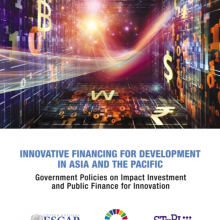Innovative Financing for Development in Asia and the Pacific

Innovative financing for development in Asia and the Pacific: Government policies on impact investment and public finance for innovation
This report provides case studies and lessons learned from seven Asian countries in five areas of innovative financing for development. Such innovative financing for development would benefit inclusive businesses as a new source of funding.
This report provides case studies and lessons learned from seven Asian countries in five areas of innovative financing for development. Such innovative financing for development would benefit inclusive businesses as a new source of funding.
Key recommendations
- Leverage national and transboundary knowledge networks on innovative financing
- Develop an impact investing strategy roadmap
- Develop problem-solving approaches for public funding for innovation
- Review and adopt regulatory framework that supports innovative financing to achieve the SDGs
- Develop innovative financing mechanisms as part of a broader innovation strategy
- Experiment, evaluate and iterate
Importance of the publication for businesses
- Gives insights about new increased funding opportunities for inclusive businesses
Importance of the publication for policymakers
- Provides insights into and evaluates emerged innovative financing initiatives, policies and economic models in Asia and the Pacific
- Provides guidelines for policymakers regarding innovative financing
The lack of financing for development is immense and therefore, innovative financing schemes are needed to bridge the gap, notably by attracting private sector capital. It must engage all relevant investment and financing stakeholders, including public sector, mainstream private sector investors, corporations, venture capital, impact investments funds and the philanthropic sector. This report focuses on five core areas of innovative financing mechanisms for development in Asia and the Pacific:
- Strategic leadership models that promote impact investing (India, Thailand and UK): Impact investor councils and taskforces engage with the public sector to advocate for policy and regulatory reforms. Taskforces support building the impact enterprise ecosystem and bridging the gap between demand and supply for impact investment.
- Policies that unlock corporate investment for development (India and Singapore): Corporate social responsibility laws mobilises corporate capital for development objectives and promote poverty reduction, education, health, environmental sustainability, gender equality, and vocational skills development. Eco-labelling regulation and other certification schemes incentivise firms to improve the production processes and empower consumers to make informed purchasing decisions.
- Private sector financing products for development (Singapore and Sri Lanka): Traditional private sector financial products like bonds and insurance schemes are also applicable for development objectives. Governments provide credit guarantees and attract private sector investments or fund insurance programmes.
- Innovative public financing models for STI (Malaysia, Republic of Korea and Japan): The Social Outcome Fund in Malaysia raises funds from investors to carry out preventive social interventions. The government monitors social outcomes of interventions and repays investors if agreed outcomes are achieved. The Fund strengthens public-private partnerships and catalyses new sources of funding. Social Problem-Solving R&D policies aim to shift the purpose of R&D from exploration theory to the search for solutions to development.
- Systematic approaches to finance and innovation for development (Republic of Korea and India): To address economic and social challenges, governments have to transform its local economy and promote sustainable development by implementing innovative ‘social economy’ policies. Governments need to test social economy policies at the small scale and use best practices of boroughs and/or small cities with similar challenges.